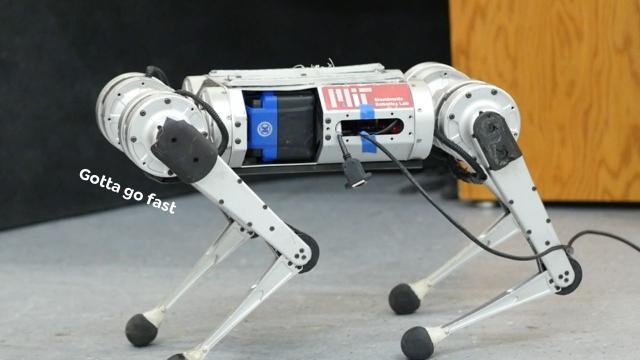MIT has been working on a “Mini Cheetah” robot that can run insanely fast.
The Mini Cheetah looks somewhat like Spot the Dog, a robotic dog built by Boston Dynamics that is used in a range of industries. While you might think this robot is the same thing, you might notice some visual differences between the two robotic animals.
For example, the mini cheetah has a body comprised of two cylinders (where you’ll find all the internals) whereas Spot the Dog has a rectangular body. The mini cheetah also lacks the plastic that Spot is covered in.
But the mini cheetah MIT is building is trying to achieve something different to Spot. Instead of being a multi-industry robot with a range of attachments and uses, this robot wants to run fast, hence the name.
This is what researchers from the Improbable AI Lab at MIT have been working on: a fast-paced mini cheetah that strides quickly. It’s suuuper creepy. Like, seriously, watch this.
Sorry I had to show you that. Am I crazy or does anyone else get creepy spider vibes from the Mini Cheetah? Like, creepy, fast-moving spider vibes, as if a Huntsman spider is about to jump on you?
MIT says that the fastest speed the Mini Cheetah has clocked is 3.9 metres per second, about 14.04 km/h. For comparison, the average man can run at about 9 km/h. A cheetah can reach up to 112 km/h.
14.04 km/h is still wicked fast for a non-vehicle. This speed was achieved through a new, trial and error, model-free learning system method MIT started to use.
What that means is actually kind of simple: the robot was put through a learning exercise in a simulator, using a “simple neural network” as the controller, according to the earlier video. In this simulator, the robot learned how to overcome challenges and run faster through simulated trial and error: the computer would simulate a problem and the robot would be tasked with overcoming it.
“Thanks to modern simulation tools, our robot can accumulate 100 days’ worth of experience on diverse terrains in just three hours of actual time,” say researchers from the team.
“We developed an approach by which the robot’s behaviour improves from simulated experience, and our approach critically also enables successful deployment of those learned behaviours in the real world.”
This change in approach allows the robot to take on challenges with greater success than earlier recorded. Not only did the robot learn to run faster, but it also learned how to operate with one leg turned ‘off’, how to walk on gravel and how to not slip on ice.
The researchers were able to shed some light on what this kind of technology and machine learning process could mean for the future.
“A more practical way to build a robot with many diverse skills is to tell the robot what to do and let it figure out the how. Our system is an example of this. In our lab, we’ve begun to apply this paradigm to other robotic systems, including hands that can pick up and manipulate many different objects,” the team added.
I hope I’m never chased by one of these creepy robots. You can read all about the project on its official website.
